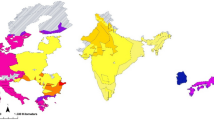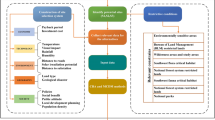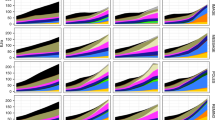Abstract
The strategic engineering of solar energy technologies—from individual rooftop modules to large solar energy power plants—can confer significant synergistic outcomes across industrial and ecological boundaries. Here, we propose techno–ecological synergy (TES), a framework for engineering mutually beneficial relationships between technological and ecological systems, as an approach to augment the sustainability of solar energy across a diverse suite of recipient environments, including land, food, water, and built-up systems. We provide a conceptual model and framework to describe 16 TESs of solar energy and characterize 20 potential techno–ecological synergistic outcomes of their use. For each solar energy TES, we also introduce metrics and illustrative assessments to demonstrate techno–ecological potential across multiple dimensions. The numerous applications of TES to solar energy technologies are unique among energy systems and represent a powerful frontier in sustainable engineering to minimize unintended consequences on nature associated with a rapid energy transition.
This is a preview of subscription content, access via your institution
Access options
Access Nature and 54 other Nature Portfolio journals
Get Nature+, our best-value online-access subscription
$29.99 / 30 days
cancel any time
Subscribe to this journal
Receive 12 digital issues and online access to articles
$119.00 per year
only $9.92 per issue
Buy this article
- Purchase on Springer Link
- Instant access to full article PDF
Prices may be subject to local taxes which are calculated during checkout



Dennis Schroeder, NREL (a left, d right); © 2018 Google (c); Greg Allen, Far Niente Winery (d left)
Similar content being viewed by others
References
Bakshi, B. R., Ziv, G. & Lepech, M. D. Techno–ecological synergy: A framework for sustainable engineering. Environ. Sci. Technol. 49, 1752–1760 (2015).
Moore-O’Leary, K. A. et al. Sustainability of utility-scale solar energy – critical ecological concepts. Front. Ecol. Environ. 15, 385–394 (2017).
Liu, J. et al. Systems integration for global sustainability. Science 347, 1258832 (2015).
Wackernagel, M. et al. Tracking the ecological overshoot of the human economy. Proc. Natl Acad. Sci. USA 99, 9266–9271 (2002).
Trainor, A. M., McDonald, R. I. & Fargione, J. Energy sprawl is the largest driver of land use change in United States. PLoS ONE 11, e0162269 (2016).
Hoffacker, M. K., Allen, M. F. & Hernandez, R. R. Land-sparing opportunities for solar energy development in agricultural landscapes: A case study of the Great Central Valley, CA, United States. Environ. Sci. Technol. 51, 14472–14482 (2017).
Griggs, D. et al. Policy: Sustainable development goals for people and planet. Nature 495, 305–307 (2013).
Carroll, A. B. & Shabana, K. M. The business case for corporate social responsibility: a review of concepts, research and practice. Int. J. Manag. Rev. 12, 85–105 (2010).
Burkhardt, J. J., Heath, G. & Cohen, E. Life cycle greenhouse gas emissions of trough and tower concentrating solar power electricity generation. J. Ind. Ecol. 16, S93–S109 (2012).
Hsu, D. D. et al. Life cycle greenhouse gas emissions of crystalline silicon photovoltaic electricity generation: systematic review and harmonization. J. Ind. Ecol. 16, S122–S135 (2012).
Heath, G. A., O’Donoughue, P., Arent, D. J. & Bazilian, M. Harmonization of initial estimates of shale gas life cycle greenhouse gas emissions for electric power generation. Proc. Natl Acad. Sci. USA 111, E3167–E3176 (2014).
O’Donoughue, P. R., Heath, G. A., Dolan, S. L. & Vorum, M. Life cycle greenhouse gas emissions of electricity generated from conventionally produced natural gas: systematic review and harmonization. J. Ind. Ecol. 18, 125–144 (2014).
Whitaker, M., Heath, G. A., O’Donoughue, P. & Vorum, M. Life cycle greenhouse gas emissions of coal-fired electricity generation. J. Ind. Ecol. 16, S53–S72 (2012).
Edenhofer, O. et al. Renewable energy sources and climate change mitigation: Special report of the Intergovernmental Panel on Climate Change (Cambridge University Press, 2011).
Cash, D. W. et al. Knowledge systems for sustainable development. Proc. Natl Acad. Sci. USA 100, 8086–8091 (2003).
McCullough, E. B. & Matson, P. A. Evolution of the knowledge system for agricultural development in the Yaqui Valley, Sonora, Mexico. Proc. Natl Acad. Sci. USA 113, 4609–4614 (2016).
Urban, F. E., Goldstein, H. L., Fulton, R. & Reynolds, R. L. Unseen dust emission and global dust abundance: documenting dust emission from the Mojave Desert (USA) by daily remote camera imagery and wind-erosion measurements. J. Geophys. Res. Atmos. 123, 8735–8753 (2018).
Roberts, B. Potential for Photovoltaic Solar Installation in Non-Irrigated Corners of Center Pivot Irrigation Fields in the State of Colorado (National Renewable Energy Laboratory, 2011).
Macknick, J., Beatty, B. & Hill, G. Overview of Opportunities for Co-Location of Solar Energy Technologies and Vegetation (National Renewable Energy Laboratory, 2013).
Hernandez, R. R. et al. Environmental impacts of utility-scale solar energy. Renew. Sustain. Energy Rev. 29, 766–779 (2014).
Sarukhán, J. & Whyte, A. (eds) Ecosystems and human well-being: synthesis (Millennium Ecosystem Assessment, 2005).
Ring, I., Hansjürgens, B., Elmqvist, T., Wittmer, H. & Sukhdev, P. Challenges in framing the economics of ecosystems and biodiversity: the TEEB initiative. Curr. Opin. Environ. Sustain. 2, 15–26 (2010).
Lambin, E. F. & Meyfroidt, P. Global land use change, economic globalization, and the looming land scarcity. Proc. Natl Acad. Sci. USA 108, 3465–7342 (2011).
Milbrandt, A. R., Heimiller, D. M., Perry, A. D. & Field, C. B. Renewable energy potential on marginal lands in the United States. Renew. Sustain. Energy Rev. 29, 473–481 (2014).
Urban, F. E., Reynolds, R. L. & Fulton, R. in Arid Environments and Wind Erosion (eds Fernandez-Barnal, A. & De La Rosa, M. A.) Ch. 11 (Nova Science Publishers, Inc, 2009).
Cooksey, G. L. S. et al. Dust exposure and coccidioidomycosis prevention among solar power farm construction workers in California. Am. J. Public Health 107, 1296–1303 (2017).
Hernandez, R. R., Hoffacker, M. K. & Field, C. B. Land-use efficiency of big solar. Environ. Sci. Technol. 48, 1315–1323 (2014).
Indragandhi, V., Subramaniyaswamy, V. & Logesh, R. Resources, configurations, and soft computing techniques for power management and control of PV/wind hybrid system. Renew. Sustain. Energy Rev. 69, 129–143 (2017).
De Marco, A. et al. The contribution of utility-scale solar energy to the global climate regulation and its effects on local ecosystem services. Glob. Ecol. Conserv. 2, 324–337 (2014).
Kenward, R. E. et al. Identifying governance strategies that effectively support ecosystem services, resource sustainability, and biodiversity. Proc. Natl Acad. Sci. USA 108, 5308–5312 (2011).
Montag, H., Parker, G. & Clarkson, T. The Effects of Solar Farms on Local Biodiversity: A Comparative Study (Clarkson and Woods and Wychwood Biodiversity, 2016).
Walston, L. J. et al. Examining the potential for agricultural benefits from pollinator habitat at solar facilities in the United States. Environ. Sci. Technol. 52, 7566–7576 (2018).
Shashua-Bar, L., Hoffman, M. E. & Tzamir, Y. Integrated thermal effects of generic built forms and vegetation on the UCL microclimate. Build. Environ. 41, 343–354 (2006).
García, F. C., Bestion, E., Warfield, R. & Yvon-Durocher, G. Changes in temperature alter the relationship between biodiversity and ecosystem functioning. Proc. Natl Acad. Sci. USA 115, 10989–10994 (2018).
Parker, S. S., Cohen, B. S. & Moore, J. Impact of solar and wind development on conservation values in the Mojave Desert. PLoS ONE 13, e0207678 (2018).
Hernandez, R. R., Hoffacker, M. K., Murphy-Mariscal, M. L., Wu, G. & Allen, M. F. Solar energy development impacts on land-cover change. Proc. Natl Acad. Sci. USA 112, 13579–13584 (2015).
Mulvaney, D. Identifying the roots of Green Civil War over utility-scale solar energy projects on public lands across the American Southwest. J. Land Use Sci. 12, 493–515 (2017).
Dupraz, C. et al. Combining solar photovoltaic panels and food crops for optimising land use: towards new agrivoltaic schemes. Renew. Energy 36, 2725–2732 (2011).
Malu, P. R., Sharma, U. S. & Pearce, J. M. Agrivoltaic potential on grape farms in India. Sustain. Energy Technol. Assess. 23, 104–110 (2017).
Amaducci, S., Yin, X. & Colauzzi, M. Agrivoltaic systems to optimise land use for electric energy production. Appl. Energy 220, 545–561 (2018).
Armstrong, A., Waldron, S., Whitaker, J. & Ostle, N. J. Wind farm and solar park effects on plant-soil carbon cycling: uncertain impacts of changes in ground-level microclimate. Glob. Change Biol. 20, 1699–1706 (2014).
Diakhaté, S. et al. Impact of simulated drought stress on soil microbiology, and nematofauna in a native shrub + millet intercropping system in Senegal. Open J. Soil Sci. 6, 189–203 (2016).
Hernandez, R. R. et al. The native shrub, Pilostigma reticulatum, as an ecological “resource island” for mango trees in the Sahel. Agric. Ecosyst. Environ. 204, 51–61 (2015).
Elimelech, M. & Phillip, W. The future of seawater desalination: energy, technology, and the environment. Science 333, 712–717 (2011).
Michailidis, P. A. & Krokida, M. K. in Food Engineering Handbook: Food Process Engineering (eds Varzakas, T. & Tzia, C.) 375–436 (CRC Press, 2014).
Jaradat, M. A. et al. A fully portable robot system for cleaning solar panels. In 10th International Symposium on Mechatronics and its Applications (ISMA) (IEEE, 2015).
García, I. F., García, A. M., Díaz, J. A. R., Barrios, P. M. & Poyato, E. C. in Water Scarcity and Sustainable Agriculture in Semiarid Environment: Tools, Strategies, and Challenges for Woody Crops (eds Tejero, I. F. G. & Zuazo, V. H. D.) 41–59 (Elsevier, 2018).
Burney, J. A. & Naylor, R. L. Smallholder irrigation as a poverty alleviation tool in Sub-Saharan Africa. World Dev. 40, 110–123 (2012).
Burney, J., Woltering, L., Burke, M., Naylor, R. & Pasternak, D. Solar-powered drip irrigation enhances food security in the Sudano-Sahel. Proc. Natl Acad. Sci. USA 107, 1848–1853 (2010).
Planning guidance for the development of large scale ground mounted solar PV systems (BRE National Solar Centre, 2013).
Spencer, R. S., Macknick, J., Aznar, A., Warren, A. & Reese, M. O. Floating photovoltaic systems: assessing the technical potential of photovoltaic systems on man-made water bodies in the continental United States. Environ. Sci. Technol. 53, 1680–1689 (2019).
Trapani, K. & Redón Santafé, M. A review of floating photovoltaic installations: 2007–2013. Prog. Photovolt. Res. Appl. 23, 524–532 (2015).
Martinez-Alvarez, V., Maestre-Valero, J. F., Martin-Gorriz, B. & Gallego-Elvira, B. Experimental assessment of shade-cloth covers on agricultural reservoirs for irrigation in south-eastern Spain. Span. J. Agric. Res. 8, 122 (2010).
Choi, Y. K. A study on power generation analysis of floating PV system considering environmental impact. Int. J. Softw. Eng. Appl. 8, 75–84 (2014).
Lienhard, J. H., Thiel, G. P., Warsinger, D. M. & Banchik, L. D. Low Carbon Desalination: Status and Research, Development, and Demonstration Needs, Report of a workshop conducted at the Massachusetts Institute of Technology in association with the Global Clean Water Desalination Alliance (Massachusetts Institute of Technology, 2016).
Pugsley, A., Zacharopoulos, A., Mondol, J. D. & Smyth, M. Global applicability of solar desalination. Renew. Energy 88, 200–219 (2016).
Taha, H. The potential for air-temperature impact from large-scale deployment of solar photovoltaic arrays in urban areas. Sol. Energy 91, 358–367 (2013).
Masson, V., Bonhomme, M., Salagnac, J.-L., Briottet, X. & Lemonsu, A. Solar panels reduce both global warming and urban heat island. Front. Environ. Sci. 2, 14 (2014).
Porfiriev, B. Evaluation of human losses from disasters: The case of the 2010 heat waves and forest fires in Russia. Int. J. Disaster Risk Reduct. 7, 91–99 (2014).
Kenrick, D. T. & Macfarlane, S. W. Ambient temperature and horn honking: a field study of the heat/aggression relationship. Environ. Behav. 18, 179–191 (1986).
Bradford, K. J. et al. The dry chain: Reducing postharvest losses and improving food safety in humid climates. Trends Food Sci. Technol. 71, 84–93 (2018).
Alvarez, L. As power grid sputters in Puerto Rico, business does too. The New York Times (15 November 2017).
Chong, W. T., Fazlizan, A., Poh, S. C., Pan, K. C. & Ping, H. W. Early development of an innovative building integrated wind, solar and rain water harvester for urban high rise application. Energy Build. 47, 201–207 (2012).
Turner, W. R. Looking to nature for solutions. Nat. Clim. Change 8, 18–19 (2018).
Ricke, K., Drouet, L., Caldeira, K. & Tavoni, M. Country-level social cost of carbon. Nat. Clim. Change 8, 895–901 (2018).
Ghassemi, F., Jakeman, A. J. & Nix, H. A. (eds) Salinisation Of Land And Water Resources: Human Causes, Extent, Management And Case Studies (CAB International, 1995).
West, T. O. & Marland, G. A synthesis of carbon sequestration, carbon emissions, and net carbon flux in agriculture: comparing tillage practices in the United States. Agric. Ecosyst. Environ. 91, 217–232 (2002).
Acknowledgements
We thank K. Lamy for assisting with graphic design and A. Diene for informational contributions. Funding for R.R.H. was provided by the UC President’s Postdoctoral Fellowship; Agricultural Experiment Station Hatch projects CA-R-A-6689-H and CA-D-LAW-2352-H; the California Energy Commission (EPC-15-060); the Department of Land, Air, and Water Resources at University of California Davis (UCD); and the John Muir Institute of the Environment, UCD. Funding for A.A. was provided by a NERC Industrial Innovation Fellowship (NE/R013489/1). Funding for M.K.H. was provided, in part, by the Energy Graduate Group, UCD. Funding for R.D. was provided by the National Renewable Energy Laboratory (NREL) through the InSPIRE Project. This work was authored, in part, by NREL (G.A.H., J.M.), operated by Alliance for Sustainable Energy, LLC, for the US Department of Energy (DOE) under Contract No. DE-AC36-08GO28308. Funding provided by the US Department of Energy Office of Energy Efficiency (EERE) and Renewable Energy Solar Energy Technologies Office (SETO), Agreement No. 34165. The views expressed in the article do not necessarily represent the views of the DOE, the US Fish and Wildlife Service, or the US Government. The US Government retains and the publisher, by accepting the article for publication, acknowledges that the US Government retains a nonexclusive, paid-up, irrevocable, worldwide license to publish or reproduce the published form of this work, or allow others to do so, for US Government purposes.
Author information
Authors and Affiliations
Contributions
R.R.H initiated the research and led the conceptual design and writing of the manuscript. All authors contributed to further content development and drafting of the manuscript.
Corresponding author
Ethics declarations
Competing interests
S.B.E. declares Wells Fargo to be his employer wherein he acts as a financier of solar and wind energy projects. All other authors declare no competing interests.
Additional information
Publisher’s note: Springer Nature remains neutral with regard to jurisdictional claims in published maps and institutional affiliations.
Supplementary information
Supplementary Information
Summary for Policy Makers, Supplementary Boxes 1–4
Rights and permissions
About this article
Cite this article
Hernandez, R.R., Armstrong, A., Burney, J. et al. Techno–ecological synergies of solar energy for global sustainability. Nat Sustain 2, 560–568 (2019). https://doi.org/10.1038/s41893-019-0309-z
Received:
Accepted:
Published:
Issue Date:
DOI: https://doi.org/10.1038/s41893-019-0309-z
This article is cited by
-
Investigating the role of subsistence renewables in alleviating power poverty within Nigeria’s energy-mix strategy
Sustainable Energy Research (2024)
-
Aligning renewable energy expansion with climate-driven range shifts
Nature Climate Change (2024)
-
China Southern Power Grid’s decarbonization likely to impact cropland and transboundary rivers
Communications Earth & Environment (2024)
-
A Framework to Model the Hydrology of Solar Farms Using EPA SWMM
Environmental Modeling & Assessment (2024)
-
Losing Ground: Targeting Agricultural Land Take by Enabling a Circular Economy in Construction
Circular Economy and Sustainability (2024)



